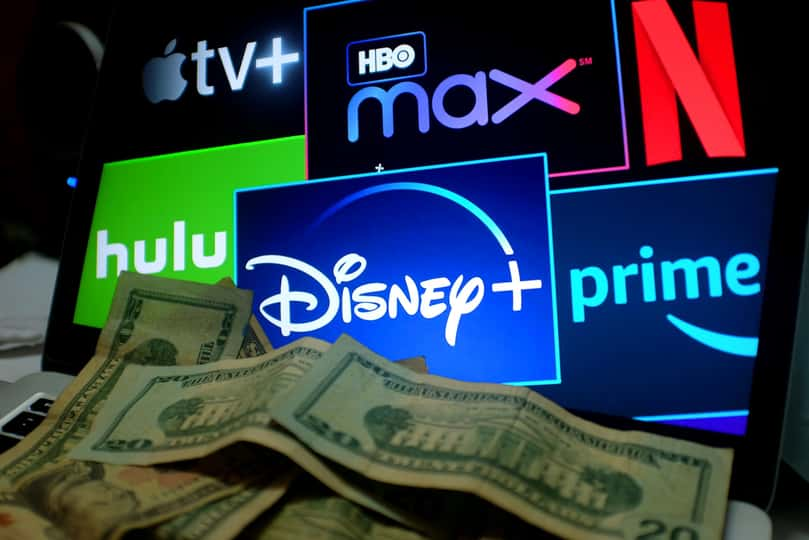People’s viewing preferences have changed drastically from television to various streaming platforms in recent years. Rapid advancements in technology are driving the growth of streaming services, internet penetration, easy on-demand accessibility, a wide range of available content, etc.
The streaming industry now has several players vying for dominance in a cutthroat market. Given the increased competition in the industry, it could be wise to avoid fundamentally weak streaming stocks The Walt Disney Company (DIS - Get Rating), Paramount Global (PARA - Get Rating), and Roku, Inc. (ROKU - Get Rating).
Before diving deeper into the fundamentals of these stocks, let’s discuss what’s happening in the streaming industry.
Netflix, Inc. (NFLX - Get Rating), which was once the undisputed king in the streaming space, saw its market share drop 5.6% year-over-year to 44.21% in the first quarter of fiscal 2023. The streaming industry has shown, on average, a monthly traffic decline of 20.2% year-over-year in the first quarter.
The dearth of new hits has also resulted in a slow start for streaming platforms this year. Amid high inflation and the consequent pressure on consumers and businesses, streaming services are being ever more cautious about spending, as they risk losing customers. This makes it increasingly challenging for streaming platforms, as it is difficult to stand out in the market.
As more competitors enter the sector offering similar services, streaming platforms are facing strong competition. These streaming players are all vying for the same viewers. This makes it difficult for streaming players as they now have to spend more on content and marketing to attract new users to their respective platforms.
Given the high level of competition present in the streaming industry, investors could look to avoid fundamentally weak streaming stocks DIS, PARA, and ROKU.
The Walt Disney Company (DIS - Get Rating)
DIS operates as an entertainment company worldwide. It operates through two segments, Disney Media and Entertainment Distribution; and Disney Parks, Experiences, and Products.
In terms of the trailing-12-month gross profit margin, DIS’ 33.40% is 33.4% lower than the 50.16% industry average. Its 14.10% trailing-12-month EBITDA margin is 21.5% lower than the 17.95% industry average. Likewise, its 5.75% trailing-12-month levered FCF margin is 21.4% lower than the 7.32% industry average.
DIS’ total segment operating income for the first quarter ended December 31, 2022, declined 7% year-over-year to $3.04 billion. Its costs and expenses widened 9.7% year-over-year to $21.52 billion. The company’s cash used in operations increased 366% year-over-year to $974 million. In addition, its cash, cash equivalents and restricted cash, end of period declined 41.2% year-over-year to $8.52 billion.
Analysts expect DIS’ EPS for the quarter ended March 31, 2023, to decline 13.9% year-over-year to $0.93. Over the past year, the stock has fallen 16.1% to close the last trading session at $97.45.
DIS’s weak fundamentals are reflected in its POWR Ratings. The stock has an overall rating of D, which equates to a Sell in our proprietary rating system. The POWR Ratings assess stocks by 118 different factors, each with its own weighting.
Within the F-rated Entertainment – Media Producers industry, it is ranked #8 out of 14 stocks. It has a D grade for Value, Momentum, and Quality. We have also given DIS grades for Growth, Stability, and Sentiment. Get all DIS ratings here.
Paramount Global (PARA - Get Rating)
PARA operates as a media and entertainment company worldwide. The company operates through TV Media, Direct-to-Consumer, and Filmed Entertainment segments
In terms of the trailing-12-month gross profit margin, PARA’s 33.49% is 33.2% lower than the 50.16% industry average. Its 9.46% trailing-12-month EBITDA margin is 47.3% lower than the 17.95% industry average. Likewise, its 1.25% trailing-12-month CAPEX/Sales is 65.5% lower than the 3.63% industry average.
PARA’s revenue for the first quarter ended March 31, 2023, declined 0.9% year-over-year to $7.26 billion. Its operating loss came in at $1.23 billion, compared to an operating income of $755 million in the prior-year quarter.
The company’s adjusted net earnings from continuing operations attributable to PARA declined 82.1% year-over-year to $72 million. Additionally, its adjusted EPS from continuing operations declined 85% year-over-year to $0.09.
PARA’s EPS for the quarter ending June 30, 2023, is expected to decline 86% year-over-year to $0.09. Its revenue during the current quarter is expected to decline 5.1% year-over-year to $7.38 billion. PARA has a bleak earnings surprise history, missing its consensus EPS estimates in three of the trailing four quarters.
Over the past year, the stock has fallen 45.7% to close the last trading session at $16.40.
PARA’s POWR Ratings reflect its grim prospects. It has an overall rating of D, which equates to a Sell. It is ranked #9 in the same industry. In addition, it has an F grade for Sentiment and a D for Growth, Momentum, and Stability.
Click here to see the other ratings of PARA for Value and Quality.
Roku, Inc. (ROKU - Get Rating)
ROKU operates a TV streaming platform. The company operates in two segments, Platform, and Devices. Its streaming platform allows users to find and access TV shows, movies, news, sports, and others.
In terms of trailing-12-month EBIT margin, ROKU’s negative 21.75% compares to the industry average of 8.12%. Its trailing-12-month Return on Common Equity of negative 24.81% compares to the industry average of 2.93%. Likewise, its negative 21.23% trailing-12-month net income margin compares to the 3.05% industry average.
For the fiscal first quarter ended March 31, 2023, ROKU’s loss from operations widened 804.5% year-over-year to $212.46 million. The company’s net loss widened 636% year-over-year to $193.60 million. Its net loss per share widened 626.3% year-over-year to $1.38.
In addition, its adjusted EBITDA loss came in at $69.08 million, compared to an adjusted EBITDA of $57.58 million. Also, its ARPU declined 5% year-over-year to $40.67.
ROKU’s EPS for the quarter ending June 30, 2023, is expected to remain negative. Over the past year, the stock has fallen 52% to close the last trading session at $52.79.
ROKU’s POWR Ratings reflect this negative outlook. It has an overall rating of F, which translates to a Strong Sell in our proprietary rating system.
Within the Consumer Goods industry, it is ranked #52 out of 53 stocks. The stock has a D grade for Growth, Value, Momentum, Stability, Sentiment, and Quality. Click here to access all the POWR Ratings of ROKU.
The Bear Market is NOT Over…
That is why you need to discover this timely presentation with a trading plan and top picks from 40 year investment veteran Steve Reitmeister:
REVISED: 2023 Stock Market Outlook >
Want More Great Investing Ideas?
DIS shares were trading at $98.70 per share on Friday morning, up $1.25 (+1.28%). Year-to-date, DIS has gained 13.60%, versus a 7.93% rise in the benchmark S&P 500 index during the same period.
About the Author: Malaika Alphonsus

Malaika's passion for writing and interest in financial markets led her to pursue a career in investment research. With a degree in Economics and Psychology, she intends to assist investors in making informed investment decisions. More...
More Resources for the Stocks in this Article
| Ticker | POWR Rating | Industry Rank | Rank in Industry |
| DIS | Get Rating | Get Rating | Get Rating |
| PARA | Get Rating | Get Rating | Get Rating |
| ROKU | Get Rating | Get Rating | Get Rating |
| NFLX | Get Rating | Get Rating | Get Rating |






